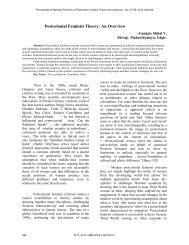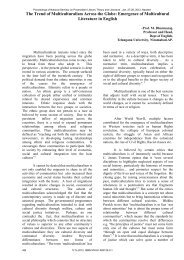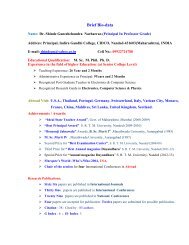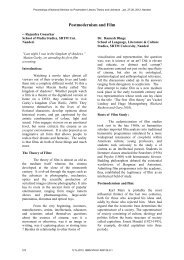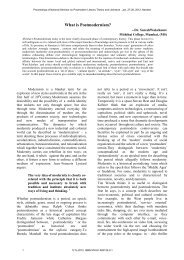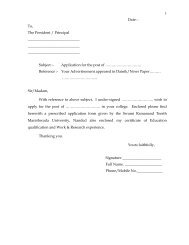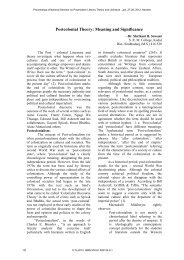Post-Structuralism: An Indian Preview - Igcollege.org
Post-Structuralism: An Indian Preview - Igcollege.org
Post-Structuralism: An Indian Preview - Igcollege.org
You also want an ePaper? Increase the reach of your titles
YUMPU automatically turns print PDFs into web optimized ePapers that Google loves.
Proceedings of National Seminar on <strong>Post</strong>modern Literary Theory and Literature , Jan. 27-28, 2012, Nanded<br />
of reality and those of ideas or the imagination—the "third order". In Lacan's psychoanalytic theory, for<br />
example, the structural order of "the Symbolic" is distinguished both from "the Real" and "the<br />
Imaginary"; similarly, in Althusser's Marxist theory, the structural order of the capitalist mode of<br />
production is distinct both from the actual, real agents involved in its relations and from<br />
the ideological forms in which those relations are understood. According to Alison Assiter, four ideas are<br />
common to the various forms of structuralism. First, that a structure determines the position of each<br />
element of a whole. Second, that every system has a structure. Third, structural laws deal with coexistence<br />
rather than change. Fourth, structures are the "real things" that lie beneath the surface or the<br />
appearance of meaning. In the 1970s, structuralism was criticized for its rigidity and ahistoricism. Despite<br />
this, many of structuralism's proponents, such as Jacques Lacan, continue to assert an influence<br />
on continental philosophy and many of the fundamental assumptions of some of structuralism's critics<br />
(who have been associated with "post-structuralism") are a continuation of structuralism.<br />
<strong>Post</strong>-structuralism is a label formulated by American academics to denote the heterogeneous works of a<br />
series of French intellectuals who came to international prominence in the 1960s and '70s. The label<br />
primarily encompasses the intellectual developments of prominent mid-20th-century<br />
French and continental philosophers and theorists. The post-structuralist movement is difficult to<br />
summarize, but may be broadly understood as a body of distinct responses to <strong>Structuralism</strong>. <strong>An</strong><br />
intellectual movement developed in Europe from the early to mid-20th century, <strong>Structuralism</strong> argued that<br />
human culture may be understood by means of a structure-—modeled on language (ie., structural<br />
linguistics)—that is distinct both from the <strong>org</strong>anizations of reality and the <strong>org</strong>anization of ideas and<br />
imagination—a third order.(Richard:p8) The precise nature of the revision or critique of structuralism<br />
differs with each post-structuralist author, though common themes include the rejection of the selfsufficiency<br />
of the structures that structuralism posits and an interrogation of the binary oppositions that<br />
constitute those structures.Writers whose work is often characterised as post-structuralist include Jacques<br />
Derrida, Michel Foucault, Gilles Deleuze, Judith Butler and Julia Kristeva. The movement is closely<br />
related to postmodernism. As with structuralism, antihumanism, as a rejection of<br />
the enlightenment subject, is often a central tenet. Existential phenomenology is a significant influence;<br />
one commentator has argued that post-structuralists might just as accurately be called "postphenomenologists."<br />
Some have argued that the term "post-structuralism" arose in <strong>An</strong>glo-<br />
American academia as a means of grouping together continental philosophers who rejected the methods<br />
and assumptions of analytical philosophy. Further controversy owes to the way in which looselyconnected<br />
thinkers tended to dispense with theories claiming to have discovered absolute truths about the<br />
world. Although such ideas generally relate only to the metaphysical (for instance, metanarratives of<br />
historical progress, such as those of dialectical materialism), many commentators have criticized the<br />
movement as relativist, nihilist, or simply indulgent to the extreme. Many so-called "post-structuralist"<br />
writers rejected the label and they don’t have any manifesto.<br />
It’s not hard to see that we are living in a time of rapid and radical social change. But it is quite hard to<br />
grasp the fact that such change will inevitably affect the nature of those disciplines that both reflect our<br />
society and help to shape it. It’s also true that inherited from the past no longer seem to fit the reality<br />
experienced by a new generation. Therefore in various parts of the world, new methods of analysis have<br />
been developed whose conclusions reveal the limitations one of Eurocentric philosophy and thinking.<br />
New concepts of literary forms and modes have been proposed new notions of the natural perception.<br />
Superstructuralism is a fine example of this. Super structuralism tries to cope with structuralism and poststructuralism<br />
harmonious.<br />
According to Harland Superstructuralism is not a theory or an ideology, rather it’s a fragmental discourse<br />
of continues thinking. He asserts –<br />
103 PLTL-2012: ISBN 978-81-920120-0-1



